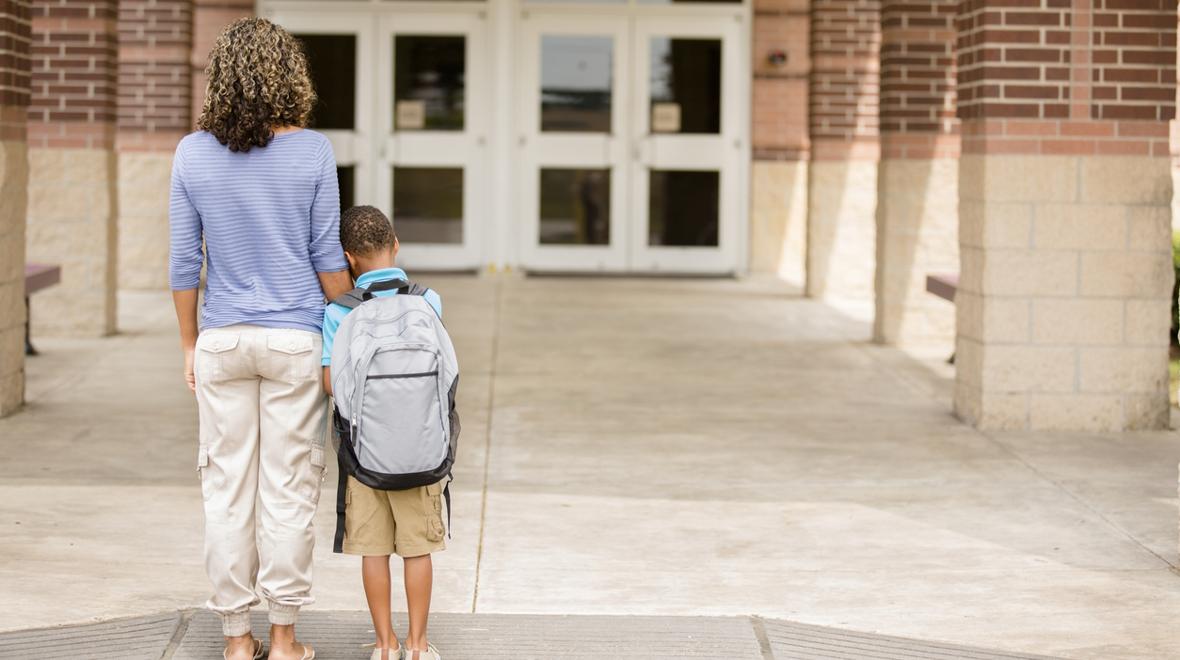
Photo:
iStock
When a child dreads going to school every day and seems to spend more time in the nurse’s office with vague illnesses than in the classroom, or a child constantly acts up in class when they should be working, it’s an obvious red flag. But it’s a lot harder to know what lies at the root of school avoidance. Children might be dealing with bullying or with anxiety. By now most parents are familiar with social anxiety, but for some children, academic anxiety — often compounded by learning or developmental difficulties — can result in learning reluctance.
Signs of anxiety
“Ten to 15 years ago, I could have told you that anxiety appears in adolescence. But unfortunately, now kids as young as 6 or 7 years old start suffering from anxiety,” says Adi Wallach, the biomedical engineer who founded CalmiGo, which makes a device to help children and adults manage their anxiety and panic attacks.
“It’s harder to diagnose anxiety when it comes to kids. In many cases, it will manifest in physical symptoms,” says Wallach.
Children have a harder time finding the words to communicate their feelings than adults do, but even describing physical symptoms can be challenging for a child. A former teacher who taught second and third grades for more than two decades before founding Northwest Kids Life Coaching, Althea Chow often suggests that children “draw on a body-shaped outline on paper the different feelings or sensations they experience when feeling stressed or anxious. Using different colors or patterns could be helpful for younger children to use instead of descriptive words.”
Physical symptoms of anxiety can include stomach pain, headaches or a ringing in the ears, tension leading to shortness of breath, sleep disruptions, loss of appetite and general soreness.
“It’s also behavioral changes that can be interpreted as tantrums — whatever it is that can express their feelings,” says Wallach. “A child that suffers from anxiety becomes, in many cases, more dependent on their parents, because anxiety is very frightening. They avoid situations and places that, first of all, will trigger their anxiety, and second, where they will be without their parents. This dependency makes the whole family more stressed and anxious, and it creates a lot of problems in school.”
Although an anxious child can exhibit a wide range of behaviors that are easily mistaken for other issues, primary indicators for anxiety are: excessive worry, physical symptoms, avoidance and difficulty in school.
Diagnosing anxiety
“It’s hard to differentiate [anxiety from other issues], and this is why it’s very recommended to do a few types of assessments to find out exactly what is going on,” says Wallach. “A lot of symptoms can be confusing, and there is also a high comorbidity between learning disabilities or ADHD and anxiety, and you don’t want to miss one of them. A child might have anxiety, but they could still have ADHD as well.”
Anxiety and learning issues can also compound one another.
“Kids with ADHD or learning disabilities, because school is harder for them than their peers, they can develop anxiety that is specifically related to learning. School will be a stressful place for them,” says Wallach. Children who are behind in school due to extended absences or who do not yet speak English fluently can also develop anxiety related to learning. At the same time, anxiety, regardless of the trigger, can impair learning.
“Because the sympathetic nervous system is very activated when a child is anxious — in a kind of fight or flight response if you will — this very badly affects their cognitive functions,” says Wallach. A child experiencing anxiety during class will demonstrate lack of attention and focus, slow processing and poor memory.
Managing anxiety
Therapy and medication may be necessary to treat anxiety, and a diagnosis is often necessary to obtain accommodations at school. With a thorough assessment, it’s possible to treat comorbidities concurrently, which can produce amazing results. While the importance of accurate assessment and diagnosis cannot be overstated, school reluctance can be the result of insecurities that do not meet diagnostic criteria for anxiety.
“Often, there is an underlying feeling of insecurity about whether they are measuring up to the expectations. If they tend to compare themselves to peers and have typically struggled to ‘perform’ or get ‘good grades’ — especially if they are highly sensitive — a student’s self-esteem can suffer with even an innocuous comment, and certainly when a tone of disapproval is used by their peers or teachers,” says Chow.
Whether you are waiting for a diagnosis or your child is simply dealing with garden-variety nerves and school pressures, “There are things that you can do right away that can be helpful,” says Wallach.
Supportive environment
“To support children experiencing anxiety about school, I recommend that parents prioritize listening to their children share about their feelings and reasoning, but hold off on trying to convince them that those reasons are unjustified or attempting to ‘fix’ a problem. Don’t rush to try to make them feel better. Continue to respond with curiosity and caring interest,” says Chow.
Teresa Sherwood, a facilitator for English language learning at Stevenson Elementary in Bellevue, says, “When you’re first learning a language, you need a little confidence boost to get over the personal risk that it feels like it is when you’re not totally sure.” The fear of making mistakes is a common theme for anxious students with learning reluctance, and one of the best ways to allay those fears is through modeling.
“A lot of that can be overcome by modeling risk-taking behavior yourself, modeling comfort with making mistakes. It can be a really big confidence boost for a lot of students,” says Sherwood. When they see adults in their lives misspelling or forgetting words, then accepting help to find answers, students learn that mistakes are not the end of the world.
“When it comes to school, creating a kind of task force, if you will, with the teacher and the parent making sure that the kid doesn’t feel judged, but feels supported — that never hurts,” says Wallach. Depending on the district, accommodations like extra time to complete assignments or a quiet space to take tests may require a diagnosis, but teachers are often able to provide some kind of individualized support, or at least some sympathy and understanding, if parents keep them in the loop.
“Sometimes school-related anxiety bubbles up because there are many unknown answers,” says Chow. Healthy routines and the elimination of surprises can give children a feeling of control.
Sherwood ensures that her students know in advance what activities are planned so that they are not surprised when they enter the classroom and can be emotionally and academically prepared.
“Routine, for kids in general but especially for anxious kids, is very helpful because it reduces a lot of their worries,” says Wallach. And if previous school failures have created an adversarial approach to homework, or your family is suffering from the kind of elevated tension Wallach describes, taking a step back to rebuild a positive environment and supportive relationship with your child is critical.
Exercise
Physical activity, especially done outdoors, is a known stress reliever.
“It’s enough just to have some time in the fresh air and to do some physical activity. They don’t need to be the next Simone Biles,” says Wallach. In fact, pushing too hard or being too competitive can be counterproductive for anxious kids.
Nutrition
Wallach acknowledges that changing a child’s diet is not easy, especially if you have an anxious child who resists any kind of change. But sugar and processed foods are associated with higher levels of stress and anxiety. It’s not necessary to convert kids to a strict whole-food diet — any incremental reduction in the amount of sugar and processed food is helpful.
“Caffeine and alcohol are usually not used by children,” says Wallach, but these can also contribute to anxiety, and parents may be surprised by the amounts of caffeine contained in sodas, sports drinks and even chocolate — items that are also usually loaded with sugar.
Mindfulness
Although adults often use meditation and mindfulness practice in response to stress and anxiety, they tend to assume that these methods are not accessible to kids. But there are many different techniques, and they can be as simple as taking a few deep breaths.
“The important thing is to find something that they can do by themselves, because you want them to be independent and feel like they can control their feelings and their anxiety,” says Wallach. This means avoiding complex routines in favor of simple practices, such as muscle relaxation using guided imagery, or breathing techniques such as box breathing or “blowing out candles.”
“Teach a child to imagine that they are blowing out birthday candles. This is something they know how to do, and it has a nice association,” says Wallach.
There are numerous picture books that help teach mindfulness and breathing to children that can be used as bedtime stories. Parents should teach their child the technique and practice it with them before expecting them to use it in the moment.
“We invented CalmiGo exactly because, even for adults, it’s not easy to do breathing techniques correctly if you are anxious or feel overwhelmed,” says Wallach. “It’s successful with kids because it’s simple and they can use it without their parents being around. They can use it in school, gaining the confidence that they can calm by themselves and stop avoiding school.”
Stay calm and carry on
“For parents who don’t suffer from anxiety, it’s hard to know how to support [their anxious child]. I would definitely recommend to ask for help,” says Wallach. Whether that’s through private therapy, coaching sessions or the resources at their child’s school, parents dealing with a learning-reluctant child benefit from the knowledge and support of others. “There are also a lot of resources online. But I would be cautious. Dr. Google is not always the best physician in the world. But things like Facebook groups for peer-to-peer support are very helpful. Although anxiety is so common, there is a lot of loneliness in this situation, both for the child and for the parent,” says Wallach.
Dealing with a child who refuses to attend or engage at school can quickly feel overwhelming. But Wallach assures parents, “It’s treatable and it won’t always be like this.”











